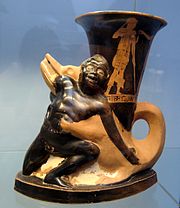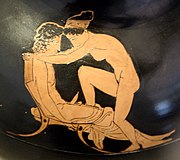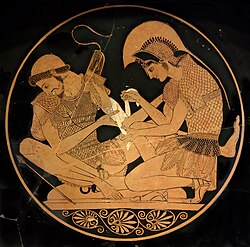Liste der griechischen Töpfer und Vasenmaler/S
Namentlich bekannte Künstler
|
Nicht namentlich bekannte Künstler (Notnamen)
| ||||||||||||||||||||||||||||||||||||||||||||||||||||||||||||||||||||||||||||||||||||||||||||||||||||||||||||||||||||||||||||||||||||||||||||||||||||||||||||||||||||||||||||||||||||||||||||||||||||||||||||||||||||||||||||||||||||||||||||||||||||||||||||||||||||||||||||||||||||||||||||||||||||||||||||||||||||||||||||||||||||||||||||||||||||||||||||||||||||||||||||||||||||||||||||||||||||||||||||||||||||||||||||||||||||||||||||||||||||||||||||||||||||||||||||||||||||||||||||||||||||||||||||||||||||||||||||||||||||||||||||||||||||||||||||||||||||||||||||||||||||||||||||||||||||||||||||||||||||||||||||||||||||||||||||||||||||||||||||||||||||||||||||||||||||||||||||||||||||||||||||||||||||||||||||||||||||||||||||||||||||||||||||||||||||||||||||||||||||||||||||||||||||||||||||||||||||||||||||||||||||||||||||||||||||||||||||||||||||||||||||||||||||||||||||||||||||||||||||||||||||||||||||||||||||||||||||||||||||||||||||
Künstler-Gruppen
| ||||||||||||||||||||||||||||||||||||||||||||||||||||||||||||||||||||||||||||||||||||||||||||||||||||||||||||||||||||||||||||||||||||||||||||||||||||||||||||||||||||||||||||||||||||||||||||||||||||||||||||||||||||||||||||||||||||||||||||||||||||||||||||||||||||||||||||||||||||||||||||||||||||||||||||||||||||||||||||||||||||||||||||||||||||||||||||||||||||||||||||||||||||||||||||||||||||||||||||||||||||||||||||||||||||||||||||||||||||||||||||||||||||||||||||||||||||||||||||||||||||||||||
Auf dieser Seite verwendete Medien
Autor/Urheber: Samos Painter, Lizenz: CC BY 2.5
Komos scene. Side B an Corinthian black-figure skyphos, ca. 585-570 BC. From Kouvara, Attica.
(c) I, Sailko, CC BY-SA 3.0
Autor/Urheber: , Lizenz: CC0
Autor/Urheber: Attributed to the Black Fury Painter, Lizenz: CC BY 2.5
Apollo holding a kithara. Fragment from a Apulian red-figure calyx-krater.
Autor/Urheber: Pig Painter, Lizenz: CC BY 2.5
The rape of Thetis by Peleus. Attic red-figure hydria, ca. 470 BC.
Maenads, women who have left their homes to follow the wine-god Dionysus, dance around this "pyxis," or cosmetics container. The animal-skin garments, snakes, and vine leaves are typical attributes of maenads and indicate their association with the wild Dionysian realm.
Autor/Urheber: Einsamer Schütze, Lizenz: CC BY-SA 4.0
Antikenmuseum der Universität Heidelberg
Achilles pursuing Troilus. Detail of side A from an Etruscan amphora of the Pontic group, ca. 540–530 BC. From Vulci.
Spacer image
Autor/Urheber: Marcus Cyron, Lizenz: CC BY-SA 3.0
Kampanisch-rotfiguriger Skyphos des Siamesen-Malers mit der Darstellung von Frauenköpfen auf Vorder- und Rückseite. um 300 v. Chr. Antikensammlung Kiel, Inventarnummer B 526.
Canthare janiforme attique à figures rouges (tête d'Héraclès et tête féminine), v. 480-460 av. J.-C. Provenance : Italie (?).
Autor/Urheber: , Lizenz: CC0
Autor/Urheber: ArchaiOptix, Lizenz: CC BY-SA 4.0
object type / vase shape: attic red figure oinochoe shape 7
- description neck: sphinx wearing a sakkos in the hair - belly: youth wearing a Thracian fox-fur cap (alopekis), holding 2 spears, on horseback, pursuing a woman running to the right - production place: Athens - painter: manner of the Bull Painter - period / date: classical, ca. 420-400 BC - material: pottery (clay) - height: 26,3 cm - museum / inventory number: Kassel, Antikensammlung (Schloss Wilhelmshöhe) ALg 16 (Ludwig collection)
- Please note: The above museum permits photography of its exhibits for private, educational, scientific, non-commercial purposes. If you intend to use the photo for any commercial aime, please contact the museum and ask for permission.Rhyton in From eines Krokodils, das einen Negerknaben gepackt hat, 460-450 v. Chr.
Fabric: ATHENIAN
Technique: RED-FIGURE Shape Name: CUP C Provenance: ITALY, ETRURIA Date: -525 to -475 Inscriptions: Kalos/Kale: STESAGORA KALOS STESAGORAS Attributed To: Recalls SALTING P by BEAZLEY Decoration: A,B: UNDECORATED I: WARRIOR Current Collection: Copenhagen, National Museum: 3879 Publication Record: Beazley, J.D., Attic Red-Figure Vase-Painters, 2nd edition (Oxford, 1963): 1609 Beazley, J.D., Attic Red-Figure Vase-Painters, 2nd edition (Oxford, 1963): 179 Burn, L. and Glynn, R., Beazley Addenda (Oxford, 1982): 92 Carpenter, T.H., with Mannack, T., and Mendonca, M., Beazley Addenda, 2nd edition (Oxford, 1989): 185 Corpus Vasorum Antiquorum: COPENHAGEN, NATIONAL MUSEUM 3, 109, PL.(141) 139.1A, 139.1B View Whole CVA Plates PHOTOGRAPH(S) IN THE BEAZLEY ARCHIVE: 1 (I)
Revue Archeologique: 1972, 161, FIG.15 (DRAWING OF I)Autor/Urheber: , Lizenz: CC BY-SA 4.0
Dieses Bild zeigt ein Denkmal, das zum Kulturerbe Italiens gehört. Dieses Denkmal nimmt am Wettbewerb Wiki Loves Monuments Italia 2016 teil.
Autor/Urheber: Picture: Marcus Cyron, Lizenz: CC BY-SA 3.0
Da ich derzeit nicht dazu komme, all meinen Bildbestand angemessen aufzubereiten, andererseits aber das material nicht sinnlos auf dem PC verkommen lassen will, habe ich mich entschlossen es mitsamt eventueller Begleittexte (die dann gelöscht werden sollten) quasi als Rohmaterial hochzuladen. Jeder ist herzlich eingeladen, Beschreibungen hinzuzufügen, Titel zu verbessern, Kategorisieren etc.
Autor/Urheber: Picture: Marcus Cyron, Lizenz: CC BY-SA 3.0
Da ich derzeit nicht dazu komme, all meinen Bildbestand angemessen aufzubereiten, andererseits aber das material nicht sinnlos auf dem PC verkommen lassen will, habe ich mich entschlossen es mitsamt eventueller Begleittexte (die dann gelöscht werden sollten) quasi als Rohmaterial hochzuladen. Jeder ist herzlich eingeladen, Beschreibungen hinzuzufügen, Titel zu verbessern, Kategorisieren etc.
Nekyia: grollend Ajas, Persephone beaufsichtigt Sisyphos mit seinem Stein in die Unterwelt. Seite A von einer schwartzfigurigen attischen Amphora, um 530 v. Chr. Aus Vulci.
Autor/Urheber: Picture taken by Marcus Cyron, Lizenz: CC BY-SA 3.0
Mann besucht eine Hetäre; Attisch-weißgrundige Lekythos mit der Kalos-Inschrift Olynpichos ist schön des Syriskos-Malers; gefunden 1879 auf dem Kareimeikos in Athen; um 480 v. Chr.; Antikensammlung Berlin, Inventarnummer F 2252
(c) Martin Rulsch, Wikimedia Commons, CC BY-SA 4.0
Fußfragment einer attisch-schwarzfigurigen Kylix im Antikenmuseum der Universität Heidelberg.
Autor/Urheber: Suckling Painter (eponymous vase), Lizenz: CC BY 2.5
Hera suckling the baby Heracles at her breast, surrounded by Aphrodite and Eros (not visible here), Athena (on the left), Iris (on the right) and a woman, perhaps Alkmene (not visible here). Detail from an Apulian red-figure squat lekythos, ca. 360-350 BC. From Anzi.
Autor/Urheber: Seated Nike Painter (Spotted Rock Group), Lizenz: CC BY 2.5
The actor Xanthias, masked and costumed, standing next to a statuette of Heracles. Detail from a Campanian red-figure oinochoe, ca. 350-340 BC.
Odysseus and the Sirens. Detail from an Attic red-figured stamnos, ca. 480-470 BC. From Vulci.
Autor/Urheber: Schilf-Maler , Lizenz: CC BY 2.5
Visit to the tomb. White-ground Attic lekythos.
Autor/Urheber: Picture taken by Marcus Cyron, Lizenz: CC BY-SA 3.0
Antikensammlung Kykladenmuseum.
Bottles of this type were frequently decorated with images of women engaged in ritual activities. Encircling the vessel are women holding wreaths in a festival dance. In the lower section, a woman bears a "kanoun," or ritual basket, on her head.
Autor/Urheber: Davide Mauro, Lizenz: CC BY-SA 4.0
Vaso del Pittore dei Cigni
Autor/Urheber: , Lizenz: CC0
Autor/Urheber: , Lizenz: CC0
Autor/Urheber: Picture taken by Marcus Cyron, Lizenz: CC BY-SA 3.0
Da ich derzeit nicht dazu komme, all meinen Bildbestand angemessen aufzubereiten, andererseits aber das material nicht sinnlos auf dem PC verkommen lassen will, habe ich mich entschlossen es mitsamt eventueller Begleittexte (die dann gelöscht werden sollten) quasi als Rohmaterial hochzuladen. Jeder ist herzlich eingeladen, Beschreibungen hinzuzufügen, Titel zu verbessern, Kategorisieren etc.
This red-figure kylix depicts a youth or a woman to the left on the tondo. The figure wears a chiton and mantle and stands before a pillar. A sakkos hangs on the right.
On the front are two women and a youth. On the left a woman stands frontally, looking right. She holds out both hands, gesturing to another woman on the far right who stands before a pillar, facing left, right arm extended. Both wear a chiton, mantle, and sakkos. In the center is a mantled youth who stands in profile to the right.
On the back three youths are depicted. The one on the left stands frontally, while looking right. Above on the left is an ivy leaf. A second mantled youth stands in profile to the right before a pillar between him and the third mantled youth who faces left. A flute case hangs between the first and second youths. The mantles of all three are pulled up around their necks; the last's extends over part of his head.
The sex of the figure in the tondo is unclear, and perhaps the painter himself forgot or changed his mind halfway through completing the figure. The dress and sakkos speak in favor of a woman, the head and stele for a youth.Hera (nach Inschrift). Tondo von einer attischen weißgrundigen Kylix, um 470 v. Chr. Aus Vulci.
Autor/Urheber: , Lizenz: CC0
Autor/Urheber: Picture: Marcus Cyron, Lizenz: CC BY-SA 3.0
Korinthisch-schwarzfigurige Pyxis des Stobart-Malers mit der Abbildung von Tieren (Widder, Panther); um 580/570 v. Chr.; Antikenmuseum der Universität Leipzig, Inventarnummer T 2335.
Autor/Urheber: Attributed to the Class of Seven Lobster-Claws, Lizenz: CC BY 2.5
Donkey. Attic red-figure rhyton in the shape of a lobster claw.
Autor/Urheber: Marcus Cyron, Lizenz: CC BY-SA 3.0
Da ich derzeit nicht dazu komme, all meinen Bildbestand angemessen aufzubereiten, andererseits aber das material nicht sinnlos auf dem PC verkommen lassen will, habe ich mich entschlossen es mitsamt eventueller Begleittexte (die dann gelöscht werden sollten) quasi als Rohmaterial hochzuladen. Jeder ist herzlich eingeladen, Beschreibungen hinzuzufügen, Titel zu verbessern, Kategorisieren etc.
Autor/Urheber: Sailko, Lizenz: CC BY-SA 4.0
Dieses Bild zeigt ein Denkmal, das zum Kulturerbe Italiens gehört. Dieses Denkmal nimmt am Wettbewerb Wiki Loves Monuments Italia 2017 teil.
Pasiphaë und der Minotaur. Tondo eines Attisch-rotfigurigen Kylix, 340-320 v. Chr. Aus Vulci.
Helen and Paris. Side A from an Apulian (Tarentum?) red-figure bell-krater, 380–370 BC.
Autor/Urheber: Picture: Marcus Cyron, Lizenz: CC BY-SA 3.0
Da ich derzeit nicht dazu komme, all meinen Bildbestand angemessen aufzubereiten, andererseits aber das material nicht sinnlos auf dem PC verkommen lassen will, habe ich mich entschlossen es mitsamt eventueller Begleittexte (die dann gelöscht werden sollten) quasi als Rohmaterial hochzuladen. Jeder ist herzlich eingeladen, Beschreibungen hinzuzufügen, Titel zu verbessern, Kategorisieren etc.
Herakles and the centaur Nessus (?). Side A of an Apulian red-figure olpe, ca. 420 BC. From Italy
Achilleus verbindet den von einem Pfeil getroffenen Patroklos. Innerseite eines attischen rotfigurigen Kylix, um 500 v. Chr. Aus Vulci.
Jüngling und Hetäre beim Liebesspiel. Detail einer attischen rotfigurigen Oinochoe, um 430 v. Chr. Aus Lokri (Italien).
Autor/Urheber: Picture: Marcus Cyron, Lizenz: CC BY-SA 3.0
Da ich derzeit nicht dazu komme, all meinen Bildbestand angemessen aufzubereiten, andererseits aber das material nicht sinnlos auf dem PC verkommen lassen will, habe ich mich entschlossen es mitsamt eventueller Begleittexte (die dann gelöscht werden sollten) quasi als Rohmaterial hochzuladen. Jeder ist herzlich eingeladen, Beschreibungen hinzuzufügen, Titel zu verbessern, Kategorisieren etc.
Aulosbläser. Attisch rotfiguriges Fragment einer Amphora, um 510 v. Chr.
Autor/Urheber: Picture taken by Marcus Cyron, Lizenz: CC BY-SA 3.0
Antikensammlung Kykladenmuseum.
This red-figure column-krater depicts Hermes on the front. He is pursuing a woman (possibly Herse) to the right. He is bearded and dressed in a chlamys with a brooch and winged boots, and has a petasos hanging down his back from his neck. In his right hand he holds a kerykeion at waist level, and he grasps her right arm with his left. Dressed in a chiton, mantle, and sakkos, she moves right, looking around, her left hand extended in front. On the right stands a bearded, elderly man (possibly Kekrops) wearing a chiton, fillet, and mantle. He holds a scepter upright in his right hand and faces left. On the far left a female companion (possibly Aglauros) flees left, looking around. She wears a chiton, mantle, and sakkos. Her right hand protrudes from the drapery beneath her chin.
On the back is a komos. On the left a mantled youth moves right, a skyphos in his left hand. In the center another youth moves right, looking around. He also holds out a skyphos in his left hand, but he gestures with his right at his side. On the right a third mantled youth stands to the left, holding a staff diagonally across his body. His left hand is covered with his mantle, and he gestures with his raised right hand. The first two wear fillets, the paint used to indicate them now mostly lost.
On the rim, in silhouette are three pairs of confronted lions and boars.
Hermes pursuing a woman is found on a number of early classical and classical red-figure vases, but none has an inscription naming the woman; thus her identity is uncertain. Most likely the woman he pursues on these vases is one of the Aglaurids, possibly Herse, while the king must be Kekrops and the other woman one of her sisters, Aglauros or Pandrosos.Black-figure dinos with stand, Attic, ca. 570 BC. Signed by Sophilos: ΣΟΦΙΛΟΣ [...] ΜΕΓΡΑΦΣΕΝ, "Sophilos drew me".
Autor/Urheber: Siren Citharist Painter, Lizenz: CC BY 2.5
Hermaphroditos-Eros in the garden of the gods. Apulian red-figure pelike, ca. 340 BC.
Autor/Urheber: Davide Mauro, Lizenz: CC BY-SA 4.0
Opera del Pittore di Siracusa 47099 Divinità femminile (Persefone?) seduta entro un tempio con ancella. All'esterno figura con torcia. 360-340 a.C.
Rape of Oreithyia by Boreas. Detail from an Apulian red-figure oenochoe, ca. 360 BC.
Autor/Urheber: , Lizenz: CC0
This red-figure kylix depicts a youth and a boy in the tondo. A youth stands nearly frontally on the left, legs crossed, head turned in profile to the right. He leans on a staff that he holds with his left hand; his right arm is bent across his chest. A boy stands nearly frontally on the right, his legs also crossed. He looks left toward the youth, as if involved in conversation. Both wear mantles. The handles are placed off the central axis.
Autor/Urheber: Sokles (potter, signed), Lizenz: CC BY 2.5
Attic black-figure kylix bearing the signature of Sokles ("Soklēs epoiēsen", "Sokles made (me)"), 570–560 BC.
Autor/Urheber: , Lizenz: CC BY-SA 4.0
Dieses Bild zeigt ein Denkmal, das zum Kulturerbe Italiens gehört. Dieses Denkmal nimmt am Wettbewerb Wiki Loves Monuments Italia 2016 teil.
Autor/Urheber: , Lizenz: CC0
Marsyas playing a pair of pipes. Athena and Apollo stand to the right, reminding the legends of the invention of the pipe (Athena) and the musical contest lost by the satyr (Apollo). Athenian red-figured column-krater, ca. 410–400 BC.
Autor/Urheber: Picture taken by Marcus Cyron, Lizenz: CC BY-SA 3.0
Da ich derzeit nicht dazu komme, all meinen Bildbestand angemessen aufzubereiten, andererseits aber das material nicht sinnlos auf dem PC verkommen lassen will, habe ich mich entschlossen es mitsamt eventueller Begleittexte (die dann gelöscht werden sollten) quasi als Rohmaterial hochzuladen. Jeder ist herzlich eingeladen, Beschreibungen hinzuzufügen, Titel zu verbessern, Kategorisieren etc.
Prothesis (mourning of the dead) scene . Attic black-figure pinax (plaque), ca. 500 BC. Found in Athens.
Autor/Urheber: ArchaiOptix, Lizenz: CC BY-SA 4.0
object type / vase shape: attic red figure cup (kylix), ancient repair
- description interior: beardless young carpenter, wearing a chlamys, working on a wooden beam - production place: Athens - painter: Carpenter Painter - period / date: late archaic, ca. 510-500 BC - material: pottery (clay) - height: 7,6 cm; diameter: 20,5 cm - findspot: Vulci (or Chiusi) - museum / inventory number: London, British Museum 1836,0224.231 Cat. Vases E 23 - bibliography: John D. Beazley, Attic Red-Figure Vase-Painters, Oxford 1963(2), 179, 1
- Please note: The above museum permits photography of its exhibits for private, educational, scientific, non-commercial purposes. If you intend to use the photo for any commercial aime, please contact the museum and ask for permission.Autor/Urheber: , Lizenz: CC0
Autor/Urheber: Black-Thyrsus Painter , Lizenz: CC0
Calydonian Boar hunt. Corinthian black-figured aryballos, ca. 580 BC.
Autor/Urheber: Schuwalow-Maler und S-Töpfer, Lizenz: CC BY 3.0
Eros. Attic red-figured oinochoe, ca. 430–425 BC. From Tanagra.







































































































































